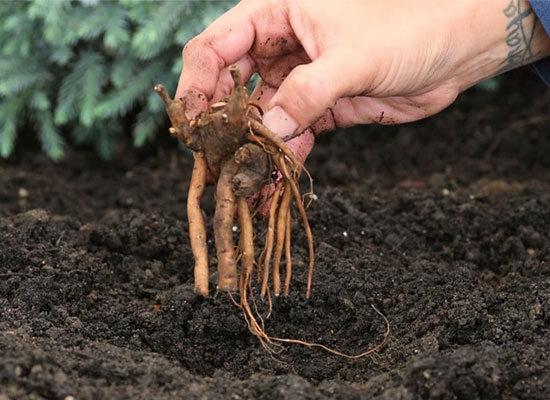Generations of gardeners have loved peonies—and with good reason. These low-maintenance perennials offer extravagant, elegant and fragrant flowers that bring joy to the garden and cut-flower arrangements in late spring to early summer. Their glossy, very ornamental foliage provides months of interest. They’re long-lived perennials—and deer and rabbits tend to leave peonies alone. Plus, peonies are super versatile in gardens and landscapes.
Some of the most popular types of peonies are the common garden peony, the tree peony, the intersectional or Itoh peony, and the woodland peony. Because peonies need a cold winter dormant season, they thrive in colder climates. Most peonies grow in zones 3-8.
Peony lovers will appreciate K. van Bourgondien’s wide selection of peonies for sale. Gardeners can choose from an array of flower colors, bloom times and flower forms, including single and double blooms. This makes it easy for gardeners and landscapers to fit peonies into their color palette and gardening style. K. van Bourgondien offers peonies for sale during both the spring and fall planting seasons.
Planting
While extremely long-lived perennials, peonies take time to get established and start blooming. They may bloom 1-3 years after planting, with most peonies flowering the second spring after planting. Your patience, though, will be rewarded with fluffy, fragrant flowers and gorgeous foliage for years and years. Once established, peonies are relatively maintenance and trouble-free perennials. The keys to successfully growing peonies are to plant them where they’ll thrive and to properly plant them.
When to Plant Peonies
The ideal time to plant peonies is in the fall, usually at least six weeks before the ground freezes. Peonies can also be planted in the spring, but they may take a bit longer before they start producing flowers.
Where to Plant Peonies
Peonies are sun lovers and most thrive in full sun, or 6-8 hours of direct sunlight daily.In southern regions, though, peonies prefer direct morning light instead of direct afternoon light. Like many other perennials, peonies don’t do well in poorly drained soils. They prefer fertile, well-drained soil rich in organic matter and with a neutral or slightly alkaline pH. If your soil is less than ideal, you can amend it with well-rotted manure or compost. While peonies like good air circulation, you’ll want to make sure they’re protected from strong winds, especially during flowering season when the plants can become quite top heavy with flowers. Avoid planting peonies too close to trees and shrubs that will compete with them for light and nourishment.
Because they’re so versatile, it’s easy to fit peonies into perennial gardens and landscapes. You can plant a specimen in the flower garden, plant several along a walkway, or create a small, flowering hedge. If you want to extend the peony season and enjoy blooms for up to six weeks, then choose a variety of early, mid-season and late season varieties. When planning your plantings, keep in mind that most peonies should be spaced 24-36″ apart.

How to Plant Peonies
For herbaceous and Itoh peonies, dig a hole that will allow you to spread out the roots without bending them. Plant the fleshy peony roots so that the eyes are no more than 1-2″ deep. If planted too deep or too shallow, peonies may not flower. Fill in soil around the roots. Water well. Cover with a thin, 2″ layer of loose mulch over winter and remove the mulch in the spring. At planting time, we also recommend staking your peonies with a hoop-type stake as the flowers can get quite heavy, causing the stems to fall.
How to Care for Peonies
If planted correctly and in the right growing conditions, peonies are easy to care for and maintain.
How to Grow Peonies
Peonies are fairly low maintenance. They have average water needs and require about 1″ of water weekly during the growing season. They require little fertilization. We recommend using K. van Bourgondien 100% Natural Perennial Food at planting time and then no more than once a year. Fertilize after the plants have bloomed. Peonies may suffer from powdery mildew in late summer or fall. Few pests, though, tend to bother the plants. Often you’ll find ants on the blooms, but it’s best to leave them be. The blooms are a food source for ants, and the ants protect the flowers from insects. Deer and rabbits tend to avoid peonies.
How to Prune Peonies
After the peony has bloomed, remove the spent flowers. After the first frost in the fall, cut the foliage to the ground and remove the foliage from the garden. This helps prevent the spread of disease.
When to Transplant Peonies
Peonies rarely need to be divided. When dividing root clumps, make sure each clump has 3-5 eyes. Plant the clumps as soon as possible after dividing them. Peonies also aren’t fond of being transplanted. Both transplanting and dividing peonies should be done in the fall.
How to Transplant Peonies
When transplanting peonies, prepare your new planting space and dig a hole before digging up the peony. Dig up the peony, leaving as much dirt around the root ball as possible. Move the root ball immediately to the new planting hole. The plant should be at the same depth it was in its previous location. Backfill the hole with dirt; gently lightly pat down the soil and water. Cover with a loose, 2″ layer of mulch.
Harvesting
Peonies are favorites as cut flowers—and their fragrance can perfume a room. To get the longest display, cut the flowers at bud stage. Buds that are about to open have the texture of a marshmallow. Cut the stems at an angle and put the stems in water with a spoonful of granulated sugar. To avoid bringing ants indoors, leave the cut flowers outdoors near the plants for an hour so the ants can travel back to the peony bushes.

